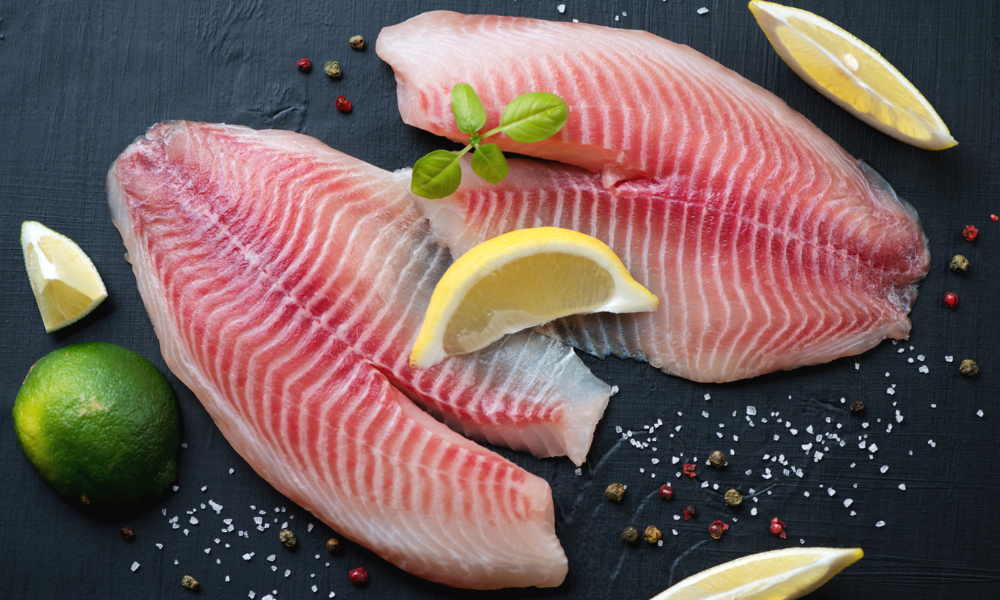Tilapia, which was first discovered in the Nile River, may be the world’s oldest farmed fish because there is proof that it was cultivated 2,500 years ago. According to biblical historians, Jesus Christ fed the hordes at the Sea of Galilee with tilapia, often known as St. Peter’s fish in contemporary eateries all around the well-known tourist spot.
Commercial fisheries worldwide generate more than 1 billion pounds of tilapia per year. The robust fish eats water plants and algae. Raising tilapia can help waters affected by red tide or strong algae blooms to become cleaner.
What is Tilapia?
Tilapia is a common name for several species of freshwater fish belonging to the Tilapiine cichlid tribe. These fish are native to various parts of Africa and the Middle East but are now widely cultivated and consumed worldwide. They are known for their adaptability to different aquatic environments and their ability to thrive in various farming systems.
Tilapia is an economically important fish species due to its fast growth rate, hardiness, and mild flavour. It is cultivated in aquaculture systems and is one of the most widely farmed fish globally. Its farming is popular due to the fish’s relatively low cost, high yield, and availability throughout the year.
There are several species of tilapia, including Nile tilapia (Oreochromis niloticus), Mozambique tilapia (Oreochromis mossambicus), and Blue tilapia (Oreochromis aureus), among others. These species can vary in size, colour, and preferred environmental conditions.
Tilapia has become a popular choice in the culinary world due to its mild flavour and versatility. Its white flesh has a delicate taste that pairs well with a variety of seasonings, herbs, and sauces. Tilapia is commonly used in various cooking methods, such as grilling, baking, frying, and steaming. It is often served as a main course, added to salads, used in fish tacos, or incorporated into soups and stews.
What Does Tilapia Taste Like?
Tilapia has a mild and relatively neutral flavour, often described as clean and slightly sweet. Its taste is not overly fishy or assertive, making it a popular choice for individuals who prefer a milder fish flavour.
The mildness of tilapia allows it to easily absorb the flavours of marinades, seasonings, or sauces used in cooking. It has a pleasant, delicate taste that is generally well-liked and appealing to a wide range of palates.
How to Serve Tilapia?
Tilapia can be served in various ways, depending on personal preference and the desired culinary experience. Here are some popular serving options for it:
Grilled
Grilling tilapia is a popular method that imparts a delicious smoky flavour to the fish. Marinate the fish in your choice of seasonings, such as lemon juice, garlic, herbs, and spices, for added flavour. Grill the tilapia fillets or whole fish over medium-high heat until cooked through and slightly charred. Serve with a squeeze of fresh lemon or lime juice.
Baked or Roasted
Baking or roasting tilapia is a simple and healthy way to cook it. Place seasoned tilapia fillets or whole fish in a preheated oven and bake at around 375°F (190°C) until the fish is opaque and easily flakes with a fork. You can add herbs, butter, lemon slices, or other ingredients on top of the fish before baking to enhance the flavour.
Pan-Fried or Sauteed
Pan-frying or sautéing tilapia is a quick and easy cooking method that results in a crispy exterior and tender flesh. Heat some oil or butter in a skillet over medium-high heat. Season its fillets with salt, pepper, and other desired spices or herbs. Cook the fillets for a few minutes on each side until golden brown and cooked through. Serve with a squeeze of lemon or a side of sauce.
Fish Tacos
It is a popular choice for fish tacos. Season the tilapia fillets with a blend of spices such as cumin, paprika, chilli powder, and garlic powder. Grill, bake or pan-fry the tilapia until cooked. Serve the cooked fish in warm tortillas and top with fresh ingredients like shredded cabbage, salsa, avocado slices, and a squeeze of lime juice.
Stir-Fried or in Curries
It can be used in stir-fries or curries for a flavorful and protein-rich meal. Cut the tilapia into bite-sized pieces and cook it with vegetables, aromatic spices, and sauces in a hot skillet or wok. Serve the stir-fried tilapia over rice or noodles, or add it to a fragrant curry sauce and serve with steamed rice.
Has Tilapia Undergone Genetic Engineering?
Most animals and fish have undergone genetic alterations as a result of selective breeding throughout time. This explains why farmed organisms often differ from their wild counterparts in appearance. Through selective breeding, an animal can produce more meat or become simpler to farm.
Genetically modified (GM) or genetically engineered plants and animals have had their DNA altered in a lab. This is a typical method for making plants resistant to illness, pests, or harmful substances like glyphosate. GM foods from Trusted sources are subject to FDA regulation and are deemed safe for ingestion.
The AquAdvantage salmon, which develops more quickly than salmon in the wild, was the first genetically altered fish that the FDA allowed. The FDA concluded that the AquAdvantage salmon was safe to consume and did not represent harm to the environment after conducting an examination. Although AquaBounty Technologies is already creating GE trout, catfish, and other fish that it hopes to sell commercially, the FDA has not yet approved any GM tilapia.
Is Tilapia Safe to Eat?
Yes, it is generally considered safe to eat. However, as with any type of food, there are some considerations to keep in mind:
Quality and Source
It is important to ensure that the tilapia you consume comes from reliable and reputable sources. Look for tilapia that has been properly handled, stored, and obtained from sustainable and responsible farming practices.
Cooking
Proper cooking is crucial to ensure the safety of tilapia. Cook tilapia thoroughly until it reaches an internal temperature of 145°F (63°C) to kill any potential bacteria or parasites. This is especially important when consuming whole fish or fillets with the skin on.
Farming Practices
Some concerns have been raised about certain farming practices used in the production of tilapia, such as the use of antibiotics, pesticides, or poor water quality in some farming systems. It is advisable to seek tilapia that comes from sustainable and responsibly managed farms that prioritize environmental stewardship and adhere to strict quality standards.
Allergies and Sensitivities
Some individuals may have allergies or sensitivities to fish. If you have known allergies or sensitivities to fish, it is important to exercise caution and consult with a healthcare professional if needed.
It’s worth noting that overall safety can depend on factors such as specific farming practices, handling, and storage conditions. If you have any concerns about the safety of tilapia or any other food, it is always best to consult with a healthcare professional or trusted authority on food safety.
How is Tilapia Raised?
Tilapia can be raised through various farming methods, including aquaculture systems and fish farms. The specific method used can vary depending on factors such as location, available resources, and production goals. Here are some common methods of raising it:
Pond Culture
Tilapia farming in ponds is one of the traditional and widely used methods. Ponds are constructed or natural water bodies are utilized to create suitable environments for tilapia growth.
Ponds are often equipped with appropriate water management systems, aeration devices, and water quality monitoring. Tilapia are stocked in the ponds and allowed to grow naturally, feeding on natural food sources or supplemental feed provided by the farmers.
Cage Culture
In cage culture, floating cages or net pens are used to hold them in large bodies of water such as lakes, reservoirs, or coastal areas. The cages provide a controlled space for tilapia while allowing water to flow through and provide natural food sources.
Supplemental feed may also be provided to enhance the growth and development of the fish. Cage culture allows for the efficient use of larger water bodies and can minimize the environmental impact of fish farming.
Recirculating Aquaculture Systems (RAS)
RAS is an intensive and controlled method of farming that recirculates and filters water within a closed system.
In RAS, tilapia are raised in tanks or indoor facilities where water quality parameters such as temperature, oxygen levels, and waste management are closely monitored and controlled.
RAS allows for year-round production and reduces the environmental impact by minimizing water usage and waste discharge.
Integrated Farming Systems
It can also be raised in integrated farming systems, where they are combined with other agricultural activities. For example, it can be raised in combination with crops in aquaponics systems, where fish waste provides nutrients for plant growth.
This integrated approach can promote resource efficiency and create symbiotic relationships between different elements of the farming system.
The specific farming practices within each method can vary, including factors such as feed management, water quality management, disease prevention, and harvesting techniques.
It’s important to note that responsible and sustainable tilapia farming practices prioritize factors such as water quality management, responsible feed sourcing, and adherence to environmental regulations to minimize any potential negative impacts on ecosystems and ensure the welfare of the fish.
Conclusion
In conclusion, tilapia is a freshwater fish that is widely cultivated and consumed worldwide. It is known for its mild flavor, versatility in cooking, and nutritional benefits. Tilapia is a lean source of protein and provides essential nutrients such as omega-3 fatty acids, vitamins, and minerals.
It is a popular choice in the culinary world due to its adaptability to different cooking methods and its ability to pair well with various seasonings and ingredients.
It is commonly used in dishes such as grilled fish, fish tacos, salads, and soups. However, it’s important to consider sustainability and responsible farming practices when purchasing it to ensure environmental stewardship.



